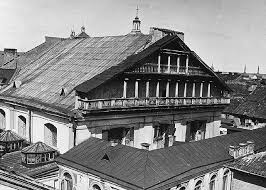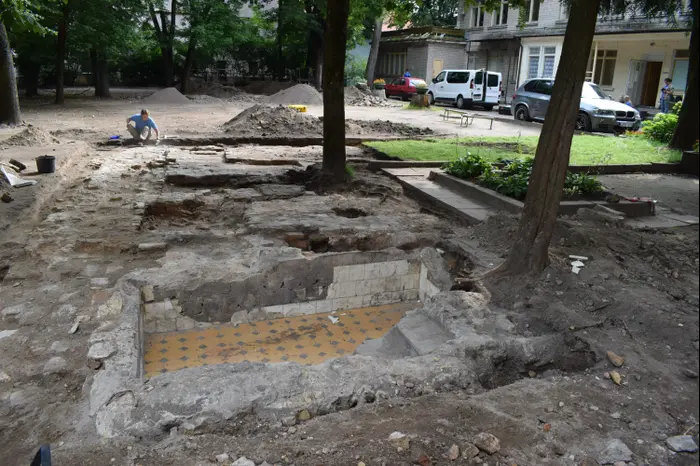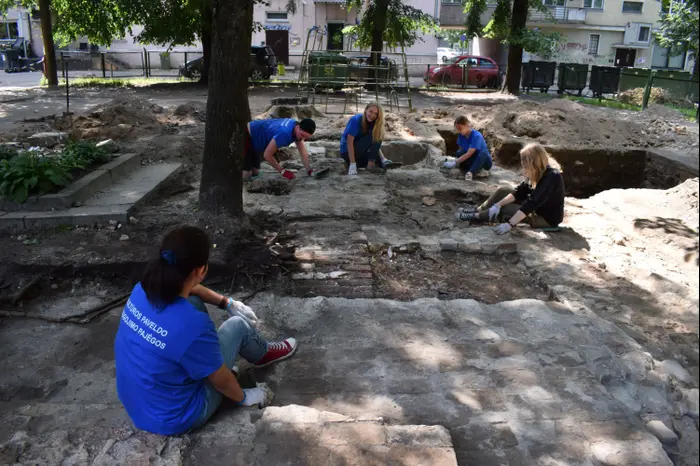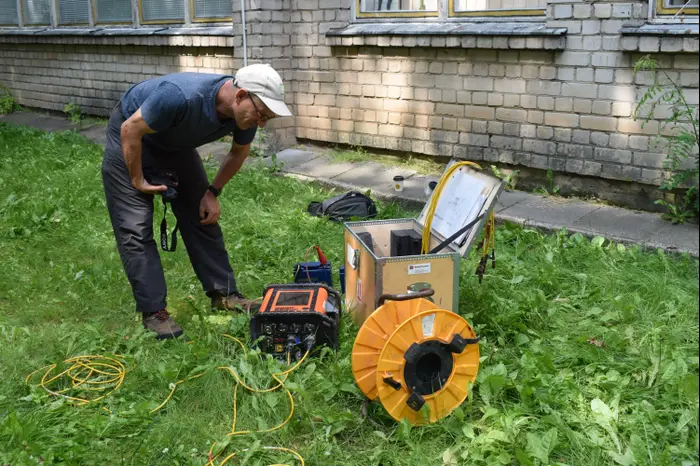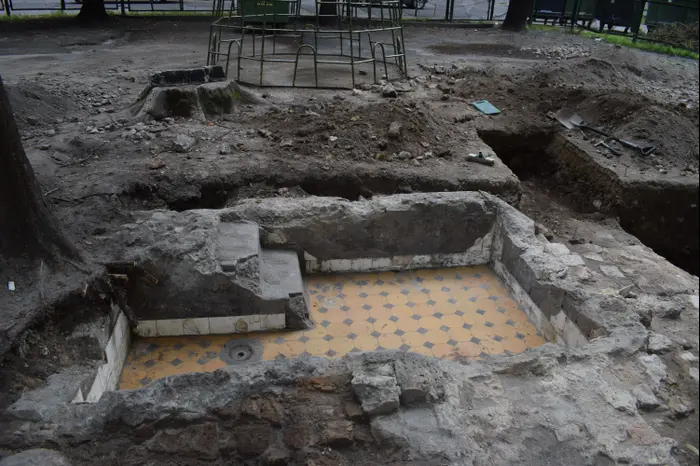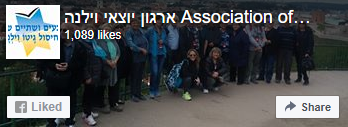The Great City Synagogue
Memorandum on perpetuation of the Great Synagogue signed in Vilnius
May 28th, 2022
By mid-2026, a unique Jewish (Litvak) shrine in the capital, the Great Vilnius Synagogue, will be restored. The Vilnius City Hall, the Jewish Community (Litvaks) of Lithuania and the Goodwill Foundation signed a Memorandum to perpetuate the synagogue.
On the territory of the synagogue, it is planned to create a memorial square of the Great Synagogue, as well as a Jewish Community Center, which will tell the general public about the Great Synagogue. Further reading...
The Great City Synagogue of Vilna, Lithuania/Haim F. Ghiuzeli
The Great City Synagogue of Vilna was built of stone from 1630 to 1633, after permission was given to build a stone structure to replace the Old Synagogue. In 1635 the synagogue was pelted with stones by rioters, the interior was destroyed and all it contained was looted.
It was rebuilt in Renaissance-Baroque style in the schulhof, and in the course of time it was surrounded by a complex of some twenty synagogues, among them an old wooden 15th century synagogue, rebuilt between the 18th and 19th century, prayer-houses of the artisans’ guilds, a beth-midrash, a mikveh, the community center, the famous Strashun rabbinical library; the prayer-house of Rabbi Eliyahu ben Solomon Zalman, The Gaon of Vilna (1720-1797), built in 1800. The whole complex became a great Talmud Torah study center and the heart of the movement of the Mitnaggedim.
The Great City Synagogue was a high one-story building with a slanted roof. In 1800 a gable with a two-tiered wooden portal was added on the western side. The entrance, with a vestibule and the “pillory” was located on the northern side of the building. The main prayer hall was square and could hold 300 people. It had a three-tiered bimah in the center, composed of twelve pillars (some say it was the gift of Rabbi Yehuda Ben-Eliezer), and it was surrounded by four pillars in Tuscan style, supporting the dome. The two-tiered Holy Ark on the eastern wall was a splendid structure, with gilded woodcarvings, representing plants, animals and Jewish symbols, with a double-headed eagle on top. On both sides of the Holy Ark there were two-story structures, serving as the women’s sections, connected to the prayer hall by little windows. Hanging from the walls and ceilings there were numerous bronze and silver chandeliers. The synagogue contained a valuable collection of ritual objects. The building was repaired in the 19th century. In 1846, when Moses Montefiore (1784-1885) and his retinue visited the synagogue, the treasurers distributed entrance tickets to the masses of people.
The synagogue was partly destroyed by the Germans during World War 2. After the war the synagogue and the whole schulhof complex were destroyed by the Soviet authorities and replaced by housing blocks.
Three original pieces from the Great Synagogue of Vilna survived the destruction quite miraculously and are now on display at the Vilna Gaon Jewish Museum: a door of the Holy Ark, a reader’s desk (Omed), and a bas-relief with the Ten Commandments.
From: Annumuseum
Great Synagogue of Vilna, Ravaged by Foes, Yields Treasures and a Priceless Hebrew Inscription
By Laura Geggel , Live Science, July 23, 2019
Inside the buried remains of the Great Synagogue of Vilna in Lithuania, archaeologists have found a priceless inscription, colorful floors, piles of coins and parts of the bimah (bee-ma) — the structure where the Torah is read and Jewish services are led, according to the Israel Antiquities Authority (IAA).
The findings are remarkable because the synagogue, historically referred to as the "Jerusalem of the North," was badly burned during World War II and later razed by the Lithuanian Soviet authorities in 1957, said Jon Seligman, the director of the synagogue's excavation and an archaeologist with the IAA.
"The Great Synagogue is the most important synagogue of Lithuania," Seligman told Live Science. "It became no less than the cathedral of the Jews of the city."
Even after it was destroyed — and a kindergarten and a primary school were built over it — archaeologists knew where the synagogue's remains were located. But with the exception of a small excavation by Lithuanian archaeologists in 2011, the site wasn't thoroughly examined until 2015, when Seligman and his colleagues used ground-penetrating radar to pinpoint the historic building's ruins before digging them out.
As excavations began, the archaeologists, including Justinas Račas of the Cultural Heritage Conservation Force of Lithuania, began finding remarkable treasures. They located two ritual baths, known as mikvahs; part of the bimah; and floor tiles, Live Science reported last year.
This past season, the archaeologists found the bimah's front section, which was originally two-stories tall in the 18th century. They also found seating plaques, a floor with beautiful red-and-black geometric designs, and a cellar underneath the bimah, which held a prayer book from before the Holocaust. In addition, there were about 200 coins dating from the 16th to the 20th centuries, and buttons from Napoleon's army, likely from when French troops passed through Vilnius before being defeated in Moscow in 1812, Seligman said.
The most important finding, however, was a large inscription that two sons had made in honor of their parents in 1796, Seligman said. This inscription "was part of a stone Torah reading table that stood on the magnificent Bimah of the synagogue in Vilnius," Seligman and Račas said in a statement from the IAA.
The two brothers — Rabbi Eliezer and Rabbi Shmuel — honored their mother, Sarah, and their father, Rabbi Chaim, who had emigrated from Lithuania to Eretz Israel and settled in Tiberias, according to the Hebrew inscription. This inscription illustrates the deep connection the Lithuanian Litvak community felt toward the
Bustling city
Vilnius became a major Jewish city starting in the 14th century, when the Lithuanian king gave Jewish people permission to settle there, Seligman previously told Live Science. At first, the synagogue was built out of wood, but in the 1600s, Italian and German architects rebuilt the city in brick, including the famed Great Synagogue.
After a fire in 1748, the synagogue was rebuilt by benefactors. But the city's authorities didn't want the synagogue to tower over its churches, so parts of the synagogue were built below street level, which is why so much of it is preserved today, Seligman previously told Live Science.
Tens of thousands of Jewish Lithuanians died in Lithuanian ghettos and concentration camps in Eastern Europe during World War II. To honor these people, as well as the Great Synagogue, the city plans to create a Jewish memorial center at the site by 2023, when Vilnius celebrates its 700th birthday, the AFP reported last year.

